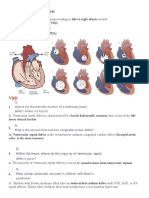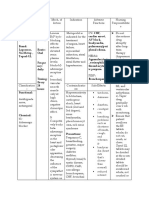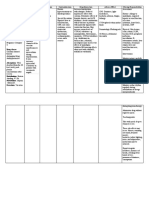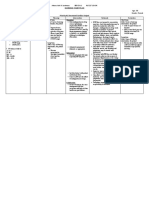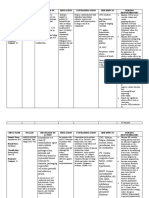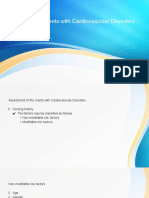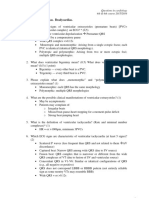0 ratings0% found this document useful (0 votes)
69 viewsDrug Name Brand Name Classification Dosage Indications Side/ Adverse Effects Nursing Responsibilities
Drug Name Brand Name Classification Dosage Indications Side/ Adverse Effects Nursing Responsibilities
Uploaded by
Ronald BurkeDopamine hydrochloride (Intropin) is an inotropic agent used to treat hemodynamic imbalances caused by shock, heart failure, or cardiac issues. It works by increasing blood pressure, cardiac output, and renal blood flow at low to medium doses but can increase the risk of arrhythmias and high blood pressure at high doses. Nurses must closely monitor patients' vital signs, IV site, urine output, and weight when administering dopamine and be prepared to treat potential side effects involving the cardiovascular, respiratory, gastrointestinal, and nervous systems.
Copyright:
© All Rights Reserved
Available Formats
Download as DOCX, PDF, TXT or read online from Scribd
Drug Name Brand Name Classification Dosage Indications Side/ Adverse Effects Nursing Responsibilities
Drug Name Brand Name Classification Dosage Indications Side/ Adverse Effects Nursing Responsibilities
Uploaded by
Ronald Burke0 ratings0% found this document useful (0 votes)
69 views2 pagesDopamine hydrochloride (Intropin) is an inotropic agent used to treat hemodynamic imbalances caused by shock, heart failure, or cardiac issues. It works by increasing blood pressure, cardiac output, and renal blood flow at low to medium doses but can increase the risk of arrhythmias and high blood pressure at high doses. Nurses must closely monitor patients' vital signs, IV site, urine output, and weight when administering dopamine and be prepared to treat potential side effects involving the cardiovascular, respiratory, gastrointestinal, and nervous systems.
Original Title
Dopamine
Copyright
© © All Rights Reserved
Available Formats
DOCX, PDF, TXT or read online from Scribd
Share this document
Did you find this document useful?
Is this content inappropriate?
Dopamine hydrochloride (Intropin) is an inotropic agent used to treat hemodynamic imbalances caused by shock, heart failure, or cardiac issues. It works by increasing blood pressure, cardiac output, and renal blood flow at low to medium doses but can increase the risk of arrhythmias and high blood pressure at high doses. Nurses must closely monitor patients' vital signs, IV site, urine output, and weight when administering dopamine and be prepared to treat potential side effects involving the cardiovascular, respiratory, gastrointestinal, and nervous systems.
Copyright:
© All Rights Reserved
Available Formats
Download as DOCX, PDF, TXT or read online from Scribd
Download as docx, pdf, or txt
0 ratings0% found this document useful (0 votes)
69 views2 pagesDrug Name Brand Name Classification Dosage Indications Side/ Adverse Effects Nursing Responsibilities
Drug Name Brand Name Classification Dosage Indications Side/ Adverse Effects Nursing Responsibilities
Uploaded by
Ronald BurkeDopamine hydrochloride (Intropin) is an inotropic agent used to treat hemodynamic imbalances caused by shock, heart failure, or cardiac issues. It works by increasing blood pressure, cardiac output, and renal blood flow at low to medium doses but can increase the risk of arrhythmias and high blood pressure at high doses. Nurses must closely monitor patients' vital signs, IV site, urine output, and weight when administering dopamine and be prepared to treat potential side effects involving the cardiovascular, respiratory, gastrointestinal, and nervous systems.
Copyright:
© All Rights Reserved
Available Formats
Download as DOCX, PDF, TXT or read online from Scribd
Download as docx, pdf, or txt
You are on page 1of 2
DRUG NAME BRAND CLASSIFICATION DOSAGE INDICATIONS SIDE/ ADVERSE NURSING
NAME EFFECTS RESPONSIBILITIES
DOPAMINE INTROPIN Inotropic Infusion Indicated for the Cardiovascular: Monitor
HYDROCHLORID Agents solution, in correction of Ventricular hemodynamics
E D5W hemodynamic arrhythmia closely: BP,
80mg/100mL imbalances present Atrial fibrillation HR, if available
160mg/100mL in the shock (at very high Obtain
320mg/100mL syndrome due to doses) parameters for
myocardial Ectopic beats hemodynamic
infarction, trauma, Fast heart rate values
(Low dose): May endotoxic Chest pain Irritation may
increase urine septicemia, open- (angina) occur at IV
output and renal heart surgery, renal Palpitation site.
blood flow failure, and chronic Cardiac Extravasation
cardiac conduction of dopamine
(Medium dose): decompensation as abnormalities may cause
May increase in congestive Slow heart rate tissue necrosis
renal blood flow, failure. Low blood to skin.
cardiac output, - SHOCK pressure Therefore,
heart rate, and - HEART (hypotension) monitor IV site
cardiac FAILURE every hour.
High blood
contractility - BRADYCARDIA Have
pressure
(hypertension) phentolamine
(High dose): May close to the
Vasoconstriction
increase blood bedside of the
pressure and patient.
stimulate Beta blockers
vasoconstriction; may
may not have a counteract
beneficial effect therapeutic
in blood effects.
pressure; may
increase risk of
tachyarrhythmia Respiratory: Cardiac
s Shortness of monitor
breath should be used
on patients
Gastrointestinal: receiving
Nausea dopamine
Vomiting infusion.
Monitor hourly
Metabolic/nutritional: urine output.
Azotemia Weigh patient
daily to
Central nervous determine
system: accurate
Headache infusion dose.
Anxiety
Endocrine:
“Goosebumps”
(piloerection)
Ocular:
Increased
intraocular
pressure
Dilated pupils
You might also like
- A Practical Guide To Fetal Echocardiography, 4e by Rabih Chaoui, Alfred AbuhamadDocument42 pagesA Practical Guide To Fetal Echocardiography, 4e by Rabih Chaoui, Alfred Abuhamadebooksonline2004100% (2)
- Pharmacology SummaryDocument16 pagesPharmacology Summarysechzhen96% (47)
- Medicine in Brief: Name the Disease in Haiku, Tanka and ArtFrom EverandMedicine in Brief: Name the Disease in Haiku, Tanka and ArtRating: 5 out of 5 stars5/5 (1)
- Drug Study DopamineDocument1 pageDrug Study Dopaminejulesubayubay542883% (6)
- Drug StudyDocument2 pagesDrug StudyPregielyn RancheNo ratings yet
- High Blood Pressure: Safe alternatives without drugsFrom EverandHigh Blood Pressure: Safe alternatives without drugsRating: 5 out of 5 stars5/5 (2)
- Basic EKG RefresherDocument210 pagesBasic EKG RefresherAaron D. Phoenix100% (8)
- Congenital Heart DefectsDocument8 pagesCongenital Heart DefectsJimy C100% (1)
- Dopamine HydrochlorideDocument1 pageDopamine HydrochlorideJoannes SanchezNo ratings yet
- Drug StudyDocument5 pagesDrug StudyLizeth Querubin93% (15)
- Adult/Child: IV 2-5 Tachycardia, Anginal PainDocument10 pagesAdult/Child: IV 2-5 Tachycardia, Anginal PainKenneth Rhoel RolaNo ratings yet
- Dopa MineDocument1 pageDopa MineJon Corpuz AggasidNo ratings yet
- Drug Study-DobutamineDocument2 pagesDrug Study-DobutamineCyril Joy N. FernandoNo ratings yet
- Drug StudyDocument49 pagesDrug StudyMitz BaldizarNo ratings yet
- BHC - Drug StudyDocument3 pagesBHC - Drug Studyboxed juiceNo ratings yet
- Ds Week 6 Nrg301 ValenzonaDocument2 pagesDs Week 6 Nrg301 ValenzonaJoshennaNo ratings yet
- Albumin Drug StudyDocument1 pageAlbumin Drug StudyMaine Concepcion100% (1)
- NSTEMI vsSTEMIDocument12 pagesNSTEMI vsSTEMIfpp6d7f9rjNo ratings yet
- Drug StudyDocument6 pagesDrug StudyGeraldine Gallaron - Casipong100% (1)
- Dx. StudyDocument3 pagesDx. Studymayumitanaka8042No ratings yet
- CRITICAL Must Print 2Document41 pagesCRITICAL Must Print 2Mohammed VHNo ratings yet
- Before: Source: Source: Source: Source: Source: Source: Source: Karch, Amy: 2009 Lippincott's Nursing Drug Guide, P. 407Document2 pagesBefore: Source: Source: Source: Source: Source: Source: Source: Karch, Amy: 2009 Lippincott's Nursing Drug Guide, P. 407SoniaMarieBalanayNo ratings yet
- Dopa MineDocument2 pagesDopa Minejohnsmith_3031No ratings yet
- Metoprolol Drug StudyDocument4 pagesMetoprolol Drug StudyCrisha Ann Billones BacutaNo ratings yet
- AmlodipineDocument2 pagesAmlodipinejiglenssNo ratings yet
- Carvedilol - Drug StudyDocument1 pageCarvedilol - Drug StudyAcads useNo ratings yet
- Drug Study AmlodipineDocument3 pagesDrug Study AmlodipineKristine ChampnessNo ratings yet
- JJK s3Document7 pagesJJK s3achurocks561No ratings yet
- PHARMACILOGY SUMMryDocument16 pagesPHARMACILOGY SUMMryKathy Real VillsNo ratings yet
- Final Drug Study-12-25Document41 pagesFinal Drug Study-12-25Poinsithia OrlandaNo ratings yet
- Drug StudyDocument2 pagesDrug StudyCen Janber CabrillosNo ratings yet
- Nursing Care Plan: Priority #1 Decreased Cardiac OutputDocument2 pagesNursing Care Plan: Priority #1 Decreased Cardiac Output1S - LASTIMOSA ATHENA IRISH D.No ratings yet
- Drug Study Emergency DrugsDocument6 pagesDrug Study Emergency DrugsJhessa Curie PitaganNo ratings yet
- Ms Midterm NotesDocument17 pagesMs Midterm NotesShaira MataganasNo ratings yet
- Final NCPDocument21 pagesFinal NCPkoringring100% (1)
- Drug Study: ER DrugsDocument5 pagesDrug Study: ER Drugsmaeca101No ratings yet
- Dopamine DRUG STUDY-ENDODocument3 pagesDopamine DRUG STUDY-ENDOaaron tabernaNo ratings yet
- Beriso Drug StudyDocument5 pagesBeriso Drug StudyKasandra Dawn Moquia BerisoNo ratings yet
- Drug Study - AmlodipineDocument2 pagesDrug Study - AmlodipineKian HerreraNo ratings yet
- Drug Study: Valerie V. Villanueva BN3-CDocument2 pagesDrug Study: Valerie V. Villanueva BN3-CA.No ratings yet
- Drug Study Dopamine HCLDocument2 pagesDrug Study Dopamine HCLA.100% (2)
- Dopamine HCLDocument1 pageDopamine HCLIvanne Hisoler100% (3)
- Arrythmias 2-3Document4 pagesArrythmias 2-3cayla mae carlosNo ratings yet
- Heart FailureDocument6 pagesHeart FailureAdnan RAHATNo ratings yet
- Amlodipine CPDocument2 pagesAmlodipine CPRose EchevarriaNo ratings yet
- Amlodipine Drug StudyDocument2 pagesAmlodipine Drug StudyRose EchevarriaNo ratings yet
- Dopamine Drug StudyDocument3 pagesDopamine Drug StudyKwin Saludares100% (1)
- AmlodipineDocument1 pageAmlodipineDeathDefying DonutNo ratings yet
- Anaesthesia in Dogs and Cats With Cardiac DiseaseDocument19 pagesAnaesthesia in Dogs and Cats With Cardiac DiseaseALEJANDRA MADRIGALNo ratings yet
- Drug Study For Nsy DRDocument4 pagesDrug Study For Nsy DRLiza M. PurocNo ratings yet
- Critical Care Medications: Vasopressors, Inotropes and Anti-Hypertensives Study Guide: Critical Care EssentialsFrom EverandCritical Care Medications: Vasopressors, Inotropes and Anti-Hypertensives Study Guide: Critical Care EssentialsNo ratings yet
- Pacemaker Syndrome, A Simple Guide To The Condition, Diagnosis, Treatment And Related ConditionsFrom EverandPacemaker Syndrome, A Simple Guide To The Condition, Diagnosis, Treatment And Related ConditionsNo ratings yet
- Atrial Fibrillation A Simple Guide to The Condition, Treatment And Related DiseasesFrom EverandAtrial Fibrillation A Simple Guide to The Condition, Treatment And Related DiseasesRating: 4 out of 5 stars4/5 (1)
- Endocrinology Notes for Medical StudentsFrom EverandEndocrinology Notes for Medical StudentsRating: 4 out of 5 stars4/5 (1)
- Cardiac Care and COVID-19: Perspectives in Medical PracticeFrom EverandCardiac Care and COVID-19: Perspectives in Medical PracticeNo ratings yet
- Immediate Life Support for healthcare Practitioners: A Step-By-Step GuideFrom EverandImmediate Life Support for healthcare Practitioners: A Step-By-Step GuideNo ratings yet
- Cardiac Tamponade, A Simple Guide To The Condition, Diagnosis, Treatment And Related ConditionsFrom EverandCardiac Tamponade, A Simple Guide To The Condition, Diagnosis, Treatment And Related ConditionsNo ratings yet
- Handbook of Inpatient CardiologyFrom EverandHandbook of Inpatient CardiologyBryan J. WellsNo ratings yet
- 2009 Handbook of Nurse Anesthesia, John J. Nagelhout, Karen Plaus PDFDocument840 pages2009 Handbook of Nurse Anesthesia, John J. Nagelhout, Karen Plaus PDFNoval Zain100% (1)
- Ekg Strip NotesDocument13 pagesEkg Strip NotesNick Loizzo100% (3)
- 3 Chapter 29 Practice Questions CardioDocument17 pages3 Chapter 29 Practice Questions CardioNursyNurseNo ratings yet
- HIPERTENSI Dan Penyakit KardiovaskularDocument39 pagesHIPERTENSI Dan Penyakit KardiovaskulardhestiNo ratings yet
- EKGDocument137 pagesEKGGbariel100% (3)
- 001 Ara Cchi Mini Glossary Cardiovascular v2Document5 pages001 Ara Cchi Mini Glossary Cardiovascular v2Smile Al MosabyNo ratings yet
- Concept Map 1Document3 pagesConcept Map 1Rubie Ann TillorNo ratings yet
- Stroke Hiperakut (Dr. Dedi Sutia, SP.N (K), FINA, MARS)Document35 pagesStroke Hiperakut (Dr. Dedi Sutia, SP.N (K), FINA, MARS)Sitti Fatwan NisakNo ratings yet
- Healing Hearts BrochureDocument2 pagesHealing Hearts Brochureapi-460602116No ratings yet
- Acute Coronary SyndromeDocument2 pagesAcute Coronary Syndromemoen bonNo ratings yet
- MIDocument22 pagesMIGagauz SiliviaNo ratings yet
- Heart FailureDocument19 pagesHeart Failureapi-647244341No ratings yet
- Nursing Care Plan (NCP) For A Patient With Angina PectorisDocument3 pagesNursing Care Plan (NCP) For A Patient With Angina PectorisKian Herrera100% (1)
- Bida2 Stroke DiagDocument6 pagesBida2 Stroke DiagKatniss Dawn Martinez DruecoNo ratings yet
- Cardiovascular DisordersDocument10 pagesCardiovascular DisordersAngel Joy CatalanNo ratings yet
- EMCrit Lae Pulmonary FlowDocument1 pageEMCrit Lae Pulmonary FlowhmsptrNo ratings yet
- Pathophysiology: Cardiovascular Diseases Coronary Artery Disease (CAD)Document5 pagesPathophysiology: Cardiovascular Diseases Coronary Artery Disease (CAD)Grace Bernadine H. Ramos100% (1)
- Cardiology LastDocument101 pagesCardiology Lastxaltra100% (1)
- Circinterventions Circcvint-2018-006837 Supp1 JR CathDocument5 pagesCircinterventions Circcvint-2018-006837 Supp1 JR CathRahayu SeptiariniNo ratings yet
- Penyakit Jantung Kongenital - TikaDocument43 pagesPenyakit Jantung Kongenital - Tikatika martikaNo ratings yet
- Kunj Sakit MeiDocument178 pagesKunj Sakit MeiParnart ChristineNo ratings yet
- VT Bradycardias AnswDocument128 pagesVT Bradycardias AnswJoshua-Majid ShahbaziNo ratings yet
- ESC Guidelines On Cardio-Oncology - 2022Document133 pagesESC Guidelines On Cardio-Oncology - 2022nicolasNo ratings yet
- Cardiopulmunary ResucitationDocument13 pagesCardiopulmunary ResucitationRussel OlivoNo ratings yet
- NURS 3940 Week 7 - Cardiovascular Dysfunction in Children - SVDocument100 pagesNURS 3940 Week 7 - Cardiovascular Dysfunction in Children - SVrlala98No ratings yet
- Osmosis Acute Coronary SyndromesDocument5 pagesOsmosis Acute Coronary Syndromesvalentinabil3No ratings yet








